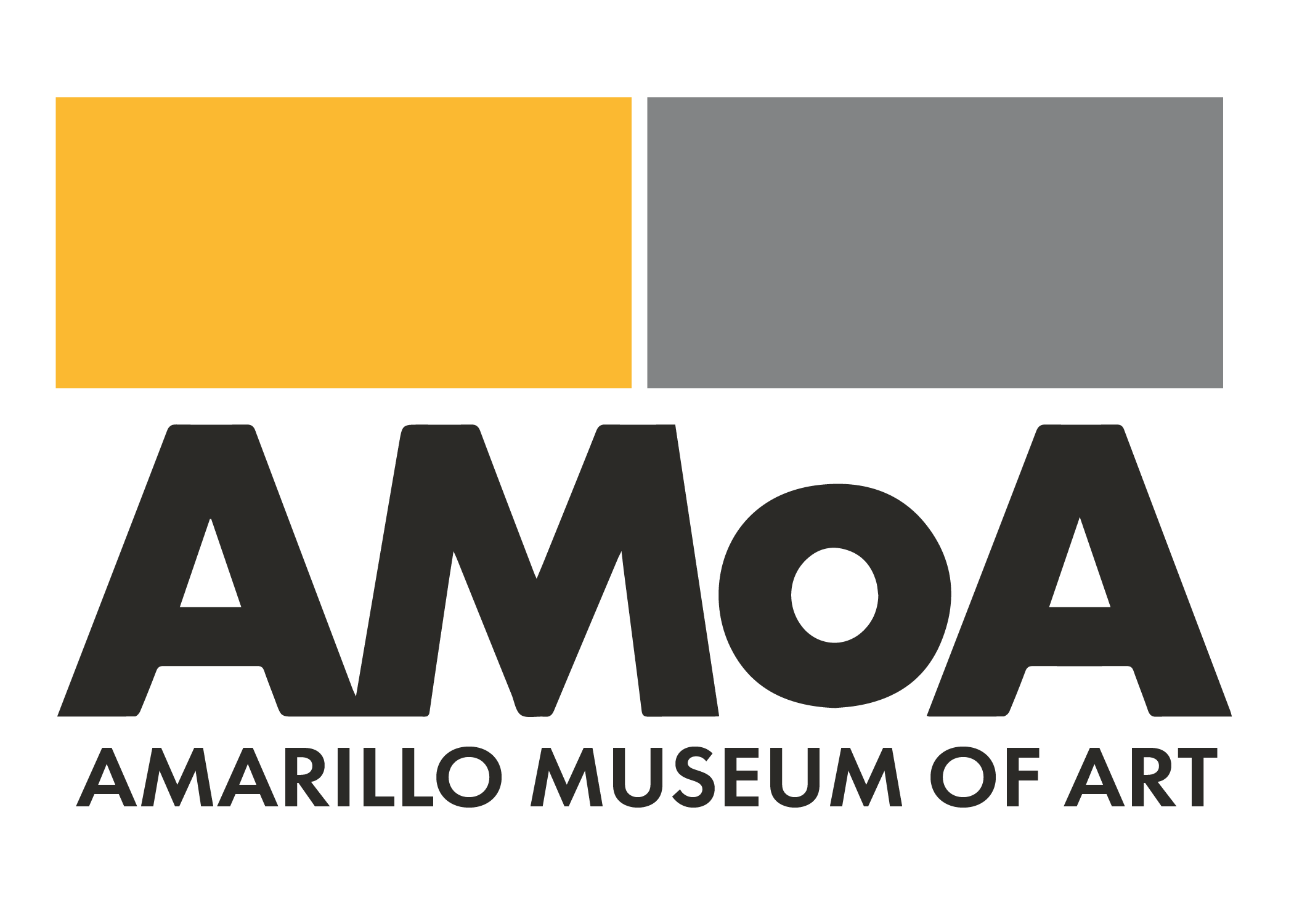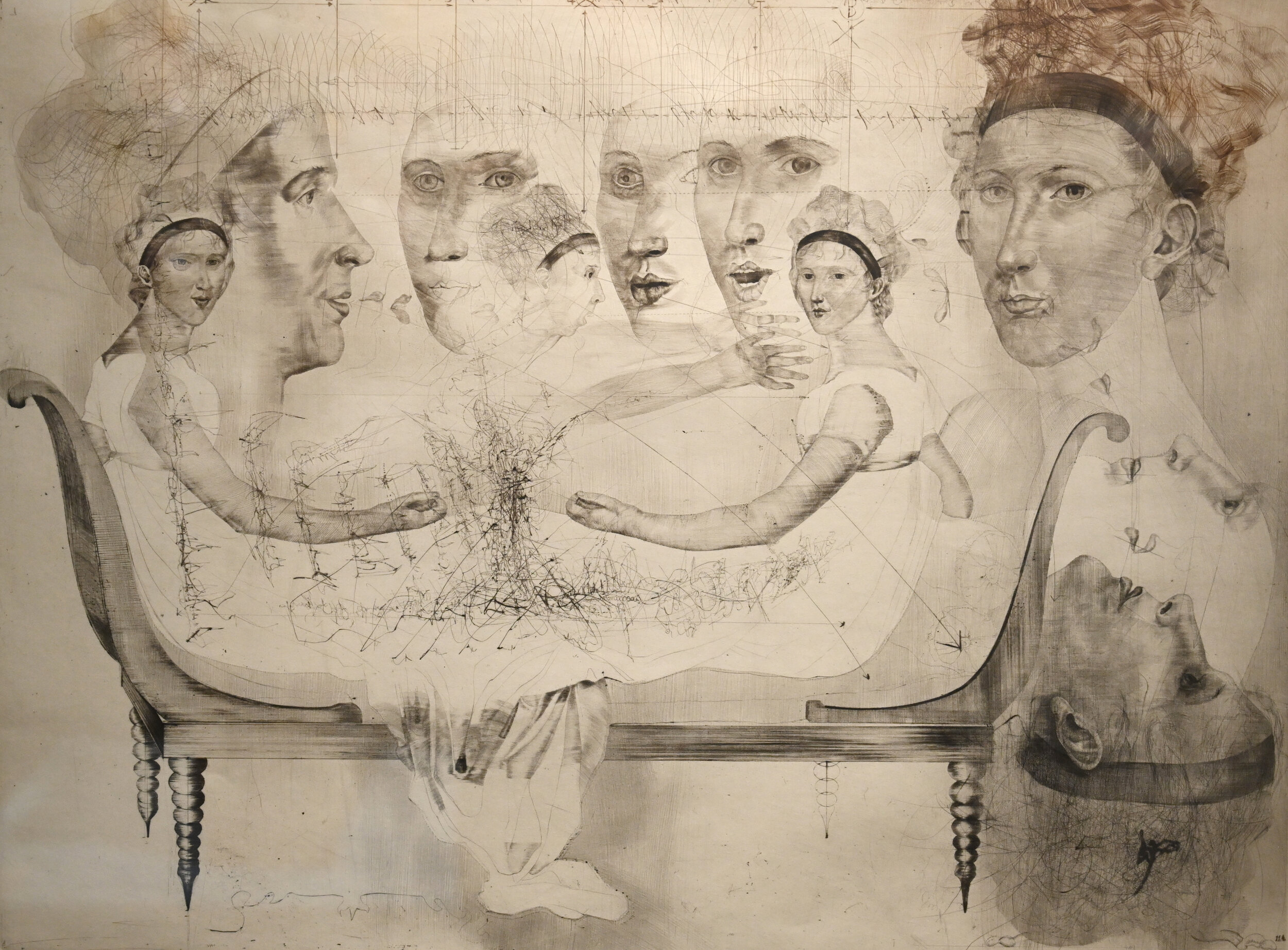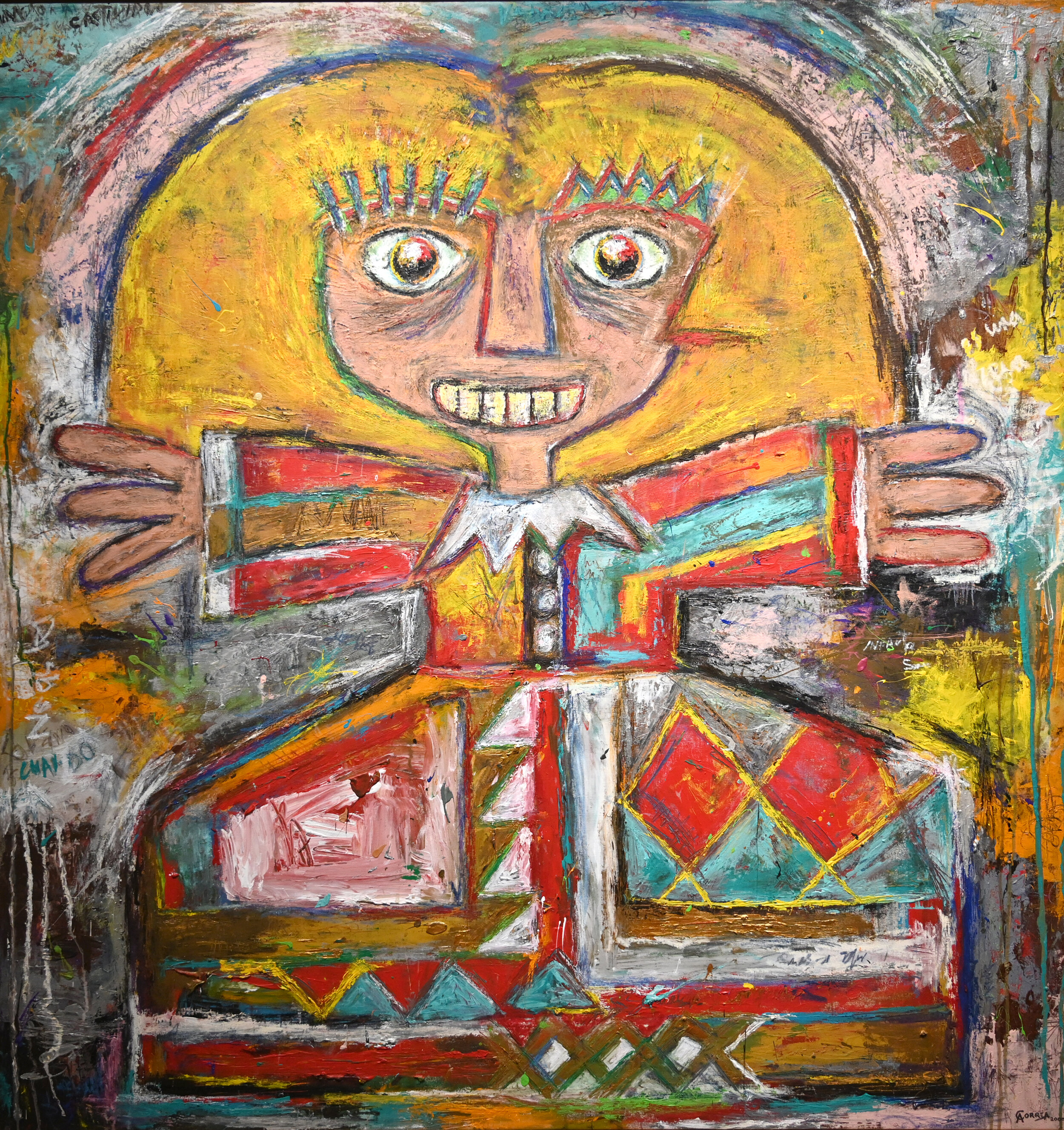There is no history of art without borrowing, which is a practice as old as art itself. Much can be learned from the art and artists that have borrowed from one another for centuries, whether through inspiration, appropriation, or reproduction. For instance, most of what we know of the ancient Greeks is through Roman copies of classical Greek sculpture. Similarly, an exploration of the AMoA permanent collection reveals several inspired examples of art from art.
DOUBLE STANDARD
EDWARD RUSCHA (American, b. 1937), Double Standard, 1969; serigraph on paper, 25 5/8 x 40 inches; Art Center Purchase; © 2021 Edward Ruscha
Originally from Oklahoma City, Ed Ruscha made the drive to and from Los Angeles many times in the 1950s and 1960s, the first time in 1956 with childhood friend and collaborator Mason Williams. On these cross-country road trips, Ruscha began to notice the ubiquitous anonymity of gasoline stations, photographing them as a sort of pictorial travelogue. Most of the photographs are taken from the perspective of the highway, with large areas of the foreground or road, which evolved into a book titled 26 Gas Stations. Included in 26 Gas Stations is a photograph of Amarillo’s Standard Station, which evolved into a larger body of prints and paintings.
Included among Ruscha’s circle of friends was actor, photographer, and art collector Dennis Hopper. Hopper’s 1961 photograph, also titled Double Standard, features a Standard gasoline station in Los Angeles. A clever image choice for the exhibition posters for Ruscha’s first exhibition of gasoline station paintings in 1964, the photograph references many of Ruscha’s artistic interests at the time; wordplay, commercial signage, gas stations, and small fires.
Read more about the friendship and collaboration between Ruscha and Williams, including early sketches of Double Standard: http://www.aldenprojects.com/search?q=double+standard
See Ed Ruscha’s 1962 photograph Standard Station, Amarillo, Texas: https://www.artsy.net/artwork/ed-ruscha-standard-station-amarillo-texas-8
See Dennis Hopper’s Double Standard photograph in the collection of the Museum of Modern Art: https://www.moma.org/collection/works/125271
ELIZABETH YAROSZ-ASH (American), Highway Robbery, 1990; watercolor on paper, 11 1/4 x 9 inches; Museum Purchase
More than 30 years after Ruscha’s Double Standard, Elizabeth Yarosz-Ash combines watercolor, typography, collage, and images of houses floating across the foreground of the iconic gas station. The houses are a recurring theme in Yarosz-Ash’s work, but in this image they assume the role of cars pulling up to the gas pumps, implying a transition from one place to another. The placeless obscurity of the gas station, when combined with the title, Highway Robbery, leaves the viewer with a sense of disequilibrium or imbalance.
MADAME RECAMIER
Juliette Recamier (1777-1849) was a French socialite and fixture of the early 19th century salon. Known for her cultivated persona, her name lives on through the numerous artworks she commissioned and in the chaise lounge that bears her name.
In 1800, Recamier commissioned the Neo-Classical painter Jacque Louis David to paint her portrait. Impatient with the artist’s slow pace, she also commissioned a portrait from another artist, Francois Gerard, sparking a heated rivalry between the two artists and motivated David to keep the original portrait in his studio until his death in 1825. It is this portrait of Recamier by David that serves as the inspiration for both Grace Hartigan and Jiri Anderle.
Explore David’s Madame Recamier in the Louvre Museum in Paris: https://collections.louvre.fr/en/ark:/53355/cl010059215
Learn more about Juliette Recamier and the many artworks she inspired: https://www.theguardian.com/world/gallery/2009/may/18/arts-women-france
JIRI ANDERLE (Czech, b. 1936), Madame Recamier (after Jacque Louis David), 1979; drypoint and mezzotint on paper, 19 5/8 x 26 1/8 inches; Gift of Grant Lawrence in honor of Roger and Sue Lawrence
Born in Czechoslovakia, Jiri Anderle is a painter and graphic artist whose aesthetic recalls the sketches of Leonardo da Vinci. Living in Prague in the midst of the Cold War, Anderle’s body of work from the 1970s consisted primarily of Vanitas, a series of etchings that questioned power and the ruling class through the recall of the aristocracy and old masters.
Borrowing imagery from David, in this etching Anderle overlaps multiple versions of Recamier’s profile in a fine, ghost-like line. The multiplicity of the faces suggests suspended individual moments, expressions that engage with and speak to the viewer, yet are removed from the present moment.
GRACE HARTIGAN (American, 1922—2008), Madame Recamier, 2005, oil on canvas, 60 x 66 inches; Museum purchase with funds from public donation
A member of the New York School of the 1950s and 1960s, Grace Hartigan was “mesmerized and fascinated” by the power of Jackson Pollock’s drip paintings when she first saw them in 1949 and began to incorporate similar elements into her own work. Firmly based in Abstract Expressionism, Hartigan is unique in that she continued to draw from the visual world around her and never truly left representational painting, despite advice from critic Clement Greenberg and others. Instead, Hartigan turned to previous figurative painters such as Rubens, Velasquez, and Goya as she worked to understand the figure and it’s place in the history of art. This early exploration led to the development of the style that would inform the rest of her artistic career.
ROGER SHIMOMURA, (American, b. 1939), Enter the Rice Cooker, 1994, Silkscreen on paper, Gift of Rick Peters
Roger Shimomura was born in Seattle, Washington in 1939 and as a young child spent two years in Idaho in a concentration camp for Japanese Americans during WWII, where he experienced the xenophobia that was prevalent at the time. Living in the Midwestern United States as a professor at the University of Kansas, and as an American-born citizen of Japanese descent, Shimomura was regularly asked questions such as “how long have you lived in the U.S.?” or “what part of Japan are you from?” In an effort to explore these unconscious stereotypes, he combines elements of American culture with Asian traditions. Borrowing imagery and aesthetics from traditional Japanese woodblock prints, such as those by Utagawa Kunisada, whose work is also found in the AMoA Permanent Collection, Shimomura contrasts traditional Japanese figures with contemporary Japanese-Americans.
SO MANY DEAD BLACK BODIES
VANESSA GERMAN (American, b. 1976), so many dead black bodies, 2014, Mixed-media assemblage, 10 3/4 x 31 15/16 x 84 inches; Loan courtesy of anonymous collection
Sculptor, painter, writer, poet, and, performer Vanessa German creates three dimensional collages from reclaimed objects and words. Choosing objects for their inherent meaning, such as personal effects, vintage objects, and cowrie shells, German continues the tradition of Marcel Duchamp’s readymade by appropriating these objects and recontextualizing them in her artwork. German’s work is similar to artist Bettye Saar in that they both create assemblages that serve as devotionals or reliquaries, connecting experiences and emotions across time. German also imbues her work with words in much the same way Ed Ruscha juxtaposes text and image, but with the intent of identifying various forms of oppression.
In this work, references to sugar through the inclusion of soda bottles and a candy tin, serve as a commentary on the production of sugar through slave labor, the relationship between sugar and poverty, and the color variations of sugar and skin tone, from white to dark brown. With this conversation, German is in dialogue with fellow artist Kara Walker, who addresses similar issues in her 2014 work A Subtlety, or the Marvelous Sugar Baby.
POLLOCK
FRANCINE TINT (American, b. 1943), Pollock, 1996/97, acrylic on canvas, 64 x 94 inches; Gift of Jeffrey Treadway
Francine Tint is an Abstract Expressionist painter who began her career in the fashion industry as a stylist. She brings that experience to her paintings, viewing both paint and fabric as a textural elements. Tint combines thick and thin layers of paint on the surface of the canvas, creating textural compositions.
Tint often titles her paintings with references to other artists, including Artemesia Gentileschi and Joan Miro. With the title of this painting, Pollock, Tint references painter Jackson Pollock (1912 – 1956), famous for his bold, gestural abstract drip paintings. Tint utilizes her whole body as she moves paint around the canvas, which she compares to the very physical painting style of Pollack, and is evident in this painting.
Both drawing inspiration from Jackson Pollock, Tint and Grace Hartigan share a foundation in Abstract Expressionism. Interestingly, Tint was also a 2004 recipient of the Pollock Krasner Grant, named for the artist and his wife and fellow artist Lee Krasner, seven years after this painting was completed.
INFANTA SOFIA
ARTURO CORREA (Venezuelan—American, b. 1967), Infanta Sofia, 2000, oil on canvas, 56 x 54 inches; Gift of Marilyn and Ivan Karp
Born in Venezuela, artist Arturo Correa moved to the United States in 1989 to study art and begin his career. Correa’s father was a surgeon and his mother was a psychologist, and their debates about health and human behavior deeply influenced the artist’s work, encouraging him to offer a different way in which to view the world.
Infanta Sofia is one of 20 works created as part of his Celebrating Mythology series. Informed by Venezuelan heritage and pre-Columbian culture, this panting borrows the shape of the title figures from Diego Velasquez’s Las Meninas, creating a contemporary interpretation by flattening the form, removing perspective, and combining the historic figure with text. Inscribed in the thick paint is the Spanish word “cuando” which translates to “when” in English, and can also serve as a commentary on the infanta’s ambiguous place in time.
Few paintings in art history have prompted as many questions or inspired as many artists as Diego Velasquez’s Las Meninas. The enigmatic group of characters can be found in Picasso’s 1957 painting The Maids of Honor (Las Meninas, after Velasquez), a cubist style recreation of the iconic work. The shape of the central figure is also mimicked in Meninas, 2002, a series of three dimensional bronze sculptures by Manolo Valdez that grace the sidewalks of the art district of Bilboa, Spain. Also inspired by Velasquez, Las Meninas by artist Simone Leigh uses terra cotta, raffia, and porcelain to address issues of race, beauty, and the female form as they relate to African traditions.
Explore Las Meninas, by Diego Velasquez, in the collection of Museo del Prado: https://www.museodelprado.es/en/the-collection/art-work/las-meninas/9fdc7800-9ade-48b0-ab8b-edee94ea877f
Compare Picasso’s The Maids of Honor (Las Meninas, after Velazquez) with the original by Velazquez: http://web.guggenheim.org/exhibitions/picasso/artworks/maids_of_honor
See Valdez’s Meninas on the streets of Bilboa: https://www.bilbaoturismo.net/BilbaoTurismo/en/outdoor-art/the-meninas
Valdez also works through the shapes in a series of two dimensional works: https://www.guggenheim-venice.it/en/art/artists/manolo-valdes/
Learn more about Simone Leigh’s Las Meninas in the galleries of the Cleveland Art Museum: https://www.clevelandart.org/art/2019.175
PERSEUS
SALVADOR DALI (Spanish, 1904—1989), Perseus – Homage to Benvenuto Cellini, 1976, bronze, 5 1/2 x 5 1/2 x 11 3/4 inches; Gift of Joseph Czestochowski, In honor of Paul and Natalie Buckthal
Spanish artist Salvador Dali (1904-1989), was a painter, printmaker, sculptor, filmmaker and writer. Influenced by Sigmund Freud and his writings on psychoanalysis, Dali explored the imagery of the subconscious in his artworks. His most famous painting, The Persistence of Memory (1931), has become an iconic example of the Surrealist movement. A prolific and flamboyant self-promoter, Dali was a persistent personality in the art world for the remainder of his career.
In similar fashion, Benvenuto Cellini was a passionate and temperamental figure of the Renaissance who is as well known for his personal life as his artistic endeavors. A sculptor and goldsmith, Cellini colorfully documented his life in a memoir begun in 1558. Titled The Autobiography of Benvenuto Cellini, in 1945 Dali illustrated the volume for Doubleday publishers.
Albeit on a much smaller scale, this Dali artwork is an almost direct copy of Cellini’s Perseus with the Head of Medusa, commissioned by Cosimo de Medici in 1545. The bronze sculpture sits in its original location in the Piazza della Signoria in Florence, surrounded by famous sculptures from the Renaissance such as Michelangelo’s David and Donatello’s Judith and Holofernes.
Watch a short video to learn more about Cellini’s Perseus with the Head of Medusa: https://www.khanacademy.org/humanities/renaissance-reformation/high-ren-florence-rome/pontormo/v/benvenuto-cellini-perseus-with-the-head-of-medusa-c-1554
M. DUCHAMP LIVES
JACK BOYNTON (American, 1928—2010), M. Duchamp Lives, 1979, offset lithograph on paper, 11 x 22 inches; Gift of the Artist
“Field where language, thought and vision act on one another,” – Jasper Johns, on Marcel Duchamp
Considered the first appropriation artist, Marcel Duchamp created the ‘readymade’ – ordinary objects selected by the artist and placed in a gallery context, essentially reinventing the object as a work of art. An important figure in the Dada movement of the early 20th century, Duchamp questioned and critiqued existing norms through irony and satire, often in the form of verbal witticisms. Dada emphasized language as the heart of reason, and the Dadaist’s ultimate act of subversion involved separating language from its intended meaning.
Jack Boynton was a Texas modernist artist who often incorporated elements of text into his artworks. By invoking the name of Duchamp in this print, Boynton connects with the aura of the readymade and Dadaism, placing the word, and by extension the artwork, firmly in the realm of the absurd.
Learn more about Marcel Duchamp, Dada, and the art of the readymade: https://www.metmuseum.org/toah/hd/duch/hd_duch.htm











